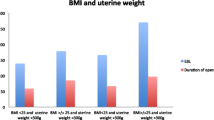Summary
To investigate the efficacy and the clinical value of total laparoscopic radical hysterectomy (TLRH) for the treatment of uterine malignancies, we performed a retrospective review of 87 patients with cervical cancer and 23 patients with endometrial carcinoma who underwent TLRH at Union hospital between June 2008 and September 2009. Data collected included operative time, estimated blood loss, lymph node count, time for the recovery of normal temperature and time to resumption of normal bladder function, intraoperative and postoperative complications. The procedure was completed laparoscopically in 108 patients. Two patients were converted to laparotomy due to common iliac vein injury. The mean overall operative time was 200.6±38.6 min; the mean operative blood loss was 280.5±128.3 mL; he mean number of pelvic lymph nodes that were resected wa26. 0±5.8. The time for recovery of normal temperature and the normal bladder function after the operation was 5.8±2.9 d and 15.2±4.3 d. There were 2 (1.8%) common iliac vein injuries during the operation and 10 (9.1%) bladder retentions post operation. It was concluded that TLRH is feasible, minimally invasive and provides promise for the treatment of uterine malignancies.
Similar content being viewed by others
References
Nezhat CR, Burrell MO, Nezhat FR, et al. Laparoscopic radical hysterectomy with paraaortic and pelvic node dissection. Am J Obstet Gynecol, 1992,166(3):864–865
Querleu D, Leblanc E, Castelain B. Laparoscopic pelvic lymphadenectomy in the staging of early carcinoma of the cervix. Am J Obstet Gynecol, 1991,164(2):579–581
Eltabbakh GH, Shamonki MI, Moody JM, et al. Laparoscopy as the primary modality for the treatment of women with endometrial carcinoma. Cancer, 2001,91(2):378–387
Lacy AM, García-Valdecasas JC, Delgado S, et al. Laparoscopy-assisted colectomy versus open colectomy for treatment of non-metastatic colon cancer: a randomised trial. Lancet, 2002, 359(9325):2224–2229
He YL, Zhang LY, Yang J, et al. Clinical analysis of radical hysterectomy plus pelvic lymphadenectomy for patients with malignant uterine tumors: laparoscopy versus laparotomy. Zhonghua Fu Chan Ke Za Zhi (Chinese), 2004,39(5):308–310
Schlaerth AC, Abu-Rustum NR. Role of minimally invasive surgery in gynecologic cancers. Oncologist, 2006, 11(8):895–901
Malzoni M, Tinelli R, Cosentino F, et al. Total laparoscopic hysterectomy versus abdominal hysterectomy with lymphadenectomy for early-stage endometrial cancer: a prospective randomized study. Gynecol Oncol, 2009, 112(1):126–133
Morgan DJ, Hunter DC, McCracken G, et al. Is laparoscopically assisted radical vaginal hysterectomy for cervical carcinoma safe? A case control study with follow up. BJOG, 2007,114(5):537–542
Gil-Moreno A, Puig O, Pérez-Benavente MA, et al. Total laparoscopic radical hysterectomy (type II–III) with pelvic lymphadenectomy in early invasive cervical cancer. J Minim Invasive Gynecol, 2005,12(2):113–120
Zakashansky K, Chuang L, Gretz H, et al. A case-controlled study of total laparoscopic radical hysterectomy with pelvic lymphadenectomy versus radical abdominal hysterectomy in a fellowship training program. Int J Gynecol Cancer, 2007,17(5):1075–1082
Pomel C, Atallah D, Le Bouedec G, et al. Laparoscopic radical hysterectomy for invasive cervical cancer: 8-year experience of a pilot study. Gynecol Oncol, 2003, 91(3):534–539
Spirtos NM, Eisenkop SM, Schlaerth JB, et al. Laparoscopic radical hysterectomy (type III) with aortic and pelvic lymphadenectomy in patients with stage I cervical cancer: surgical morbidity and intermediate follow-up. Am J Obstet Gynecol, 2002,187(2):340–348
Obermair A, Ginbey P, McCartney AJ. Feasibility and safety of total laparoscopic radical hysterectomy. J Am Assoc Gynecol Laparosc, 2003,10(3):345–349
Nezhat F. Triumphs and controversies in laparoscopy: the past, the present, and the future. JSLS, 2003,7(1):1–5
Ramirez PT, Slomovitz BM, Soliman PT, et al. Total laparoscopic radical hysterectomy and lymphadenectomy: the M. D. Anderson Cancer Center experience. Gynecol Oncol, 2006,102(2):252–255
Lee CL, Huang KG, Wang CJ, et al. Laparoscopic radical hysterectomy using pulsed bipolar system: comparison with conventional bipolar electrosurgery. Gynecol Oncol, 2007,105(3):620–624
Schlaerth AC, Abu-Rustum NR. Role of minimally invasive surgery in gynecologic cancers. Oncologist, 2006, 11(8):895–901
Raspagliesi F, Ditto A, Fontanelli R, et al. Type II versus Type III nerve-sparing radical hysterectomy: comparison of lower urinary tract dysfunctions. G Gynecol Oncol, 2006,102(2):256–26
Campagnacci R, de Sanctis A, Baldarelli M, et al. Electrothermal bipolar vessel sealing device vs. ultrasonic coagulating shears in laparoscopic colectomies: a comparative study. Surg Endosc, 2007,21(9):1526–1531
Kunde D, Welch C. Ultracision in gynaecological laparoscopic surgery. J Obstet Gynaecol, 2003,23(4):347–352
Katahira A, Niikura H, Kaiho Y, et al. Intraoperative electrical stimulation of the pelvic splanchnic nerves during nerve-sparing radical hysterectomy. Gynecol Oncol, 2005,98(3):462–466
Maas CP, Kenter GG, Trimbos JB, et al. Anatomical basis for nerve-sparing radical hysterectomy: immunohistochemical study of the pelvic autonomic nerves. Acta Obstet Gynecol Scand, 2005,84(9):868–874
Yan XY, Li GY, Chen LS, et al. The safety analysis of laparoscopic radical hysterectomy and pelvic lymphadnectomy for uterine malignance. Chin J Practical Gyn Obst (Chinese), 2007,23(12):945–947
Author information
Authors and Affiliations
Corresponding author
Rights and permissions
About this article
Cite this article
Shen, Y., Wang, Z. Total laparoscopic radical hysterectomy for treatment of uterine malignant tumors: Analysis of short-term therapeutic efficacy. J. Huazhong Univ. Sci. Technol. [Med. Sci.] 30, 375–378 (2010). https://doi.org/10.1007/s11596-010-0360-5
Received:
Published:
Issue Date:
DOI: https://doi.org/10.1007/s11596-010-0360-5




